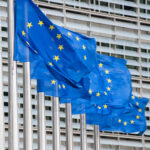Six months after the beginning of Russia’s brutal war against Ukraine we ask the question: Has the European Union done enough to cut its dependence on Russian gas and oil?
Russian energy revenues are set to “rise this year by nearly $100 billion as higher commodity prices offset a decrease in volumes.” Compared to 2021 when Russia’s revenue from energy exports amounted to roughly $244 billion, this year energy experts forecast $338 billion in income mainly because of the rising prices of energy. Revenues from energy exports amount to almost “45 percent of the federal budget”. In other words, they contribute significantly to funding Moscow’s war efforts in Ukraine.
In this article, we explore what has the EU done so far to cut its reliance on Russian energy imports and the plans for the coming winter where soaring prices and the possibility of energy shortage might spark a backlash in European capitals.
How much does the EU’s dependency on energy “contribute” to the Russian budget?
On 4 May, European Commission President Ursula von der Leyen called for a “complete import ban on all Russian oil, seaborne and pipeline, crude and refined.” A watered-down version granting a temporary exemption for pipeline-delivered crude oil was later adopted by the Council, mainly due to Hungary’s objections. Victor Orban “boasted” by stating “We have managed to defeat the Commission’s proposal to ban the use of oil from Russia in Hungary.” However, EU leaders did agree on a sanctions package including the phasing in of an import ban on Russian seaborne crude oil and petroleum products, with a transition period of 6 to 8 months while exempting pipeline-delivered crude oil.
More than three months after the invasion, the New York Times reported on a study conducted by the Centre for Research on Energy and Clean Air (CREA). It concluded that “Russia’s revenues from fossil fuels… soared to records in the first 100 days of its war on Ukraine,” amounting to “a record €93 billion in revenue from exports of oil, gas and coal.” While a ban on coal and oil imports from Russia was agreed, a ban on gas imports is currently off the cards. Countries such as Germany are simply too dependent on Russian natural gas.
This is hardly surprising given that EU countries have been at the forefront of Russia’s combined revenues from fossil fuels: 61 percent of all Russian exports go to the EU, and they were worth around €57 billion annually. Germany, Italy, and the Netherlands are among the five largest importers, followed by Turkey, Poland, and France.
In August, speaking at the “Quo Vadis Europa” conference, the High Representative of the EU for Foreign Affairs and Security Policy Josep Borrell said: “Keep in mind that Europe consumes 400 bcm [billion cubic meters of gas] per year. 40 percent of that consumption was imported by Russia. Now we are already at 20 percent.” Borrell then asked: “The problem is: What do we do with the other 20 percent?”

Downing Street, London | UK – 2022.02.26: Ukrainian people protest, thousands gather to demand tougher sanctions on Russia from British Government, EU and USA to stop the war in Ukraine. Shutterstock/Sandor Szmutko
EU and the US symmetry ban on energy products from Russia
In March, US President Joe Biden signed a comprehensive executive order banning “the importation into the United States of the following products of Russian Federation origin: crude oil; petroleum; petroleum fuels, oils, and products of their distillation; liquefied natural gas; coal; and coal products.” This came as little surprise – US imports of Russian oil and refined products in 2021 amounted to only 8 percent of its total imports of crude oil and petroleum products, while the EU’s dependency on Russian energy is far greater.
In March, Eurostat published a figure that said that “energy represented 62 percent of EU total imports from Russia”. This is considerably less than ten years ago when energy represented almost 77 percent of EU imports from Russia. In 2021, the EU imported more than “40 percent of its total gas consumption, 27 percent of oil imports, and 46 percent of coal imports from Russia.”
A plan for more reliant and sustainable energy sources?
In May, the European Commission presented its “REPower EU Plan” aimed at ending – “as soon as possible” – EU’s dependence on Russian fossil fuels imports, in addition to paving the way for a green transition as a response to climate changes. The ambitious plan consists of several measures: 1) energy savings; 2) diversifying energy imports; 3) substituting fossil fuels and accelerating Europe’s clean energy transition; 4) smart investment; 5) reinforcing preparedness.
A core part of the plan includes the diversification of energy imports as a response to Russia’s war in Ukraine and the use of energy resources as a powerful political tool for influencing the decision-making processes in the European Union and its member countries. By severing Russian energy as a blackmail tool and transitioning to energy deliveries from other countries, as well as creating renewable energy sources the European Union wants to become more resilient, climate-friendly, and more self-sustaining over the course of the next decades.
Imports of coal from Russia have been effectively banned since 10 August 2022. As evidenced by Bruegel’s figure below, EU natural gas imports from Russia have fallen steadily but also significantly from May 2022 compared to the same period of 2021. As an example, during the week of 8-14 August 2021, the EU imported around 2742 million cubic meters of natural gas. In the same week in 2022, the EU imported only 846 million cubic meters.
Diversification and alleviating Europe’s energy dependence on Russia
The EU’s diversification scheme to replace Russian energy took some by surprise considering the unusual list of potential suppliers – Azerbaijan, Egypt, and even Nigeria – amid human rights concerns. In late March, during US President Joe Biden’s three-day visit to the European Union, an agreement was signed that will “see the US provide the EU with extra gas, equivalent to around 10 percent of the gas it currently gets from Russia, by the end of the year.” On top of the 22 billion cubic meters that the US provided in 2021, the aim of this agreement will be for the “US and international partners to provide about 50 billion cubic meters per year to the EU.”
In July, the president of the European Commission, Ursula von der Leyen, traveled to Baku to meet with Azerbaijan’s President Ilham Aliyev. Both signed a ‘Memorandum of Understanding on a Strategic Partnership in the Field of Energy’ with her counterpart aimed at doubling the capacity of the Southern Gas Corridor to up to at least 20 billion cubic meters annually as of 2027. A month before that, the EU signed another memorandum of understanding – with Egypt and Israel. The two countries agreed to work towards “enabling a stable delivery of natural gas to the EU”. The plan is to eventually ship Israeli natural gas from its gas fields in the Mediterranean via the already existing LNG infrastructure in Egypt.
Reducing gas usage to manage the upcoming winter
Besides the search for new or “trustworthy” suppliers, as von der Leyen mentioned, the EU started to implement gas-cut measures at home for the coming winter. Dubbed the “Save Gas for a Safe Winter” plan, it involves a “voluntary gas demand reduction target of 15 percent from 1 August 2022 to 31 March 2023” as the winter looms and Russia’s weaponization of energy toward the EU becomes more distinct.
The EU Council adopted a regulation on gas storage mid-summer following a provisional agreement with the European Parliament in May. The regulation stipulates that Eu member states need to have underground gas storage levels at “80 percent of their capacity” before the winter period of 2022 and overall “85 percent of the total underground gas storage capacity in the EU in 2022.” For the following winter periods, the target is set at 90 percent. On the last day of August, the bloc’s Energy Commissioner Kadri Simmons announced that the “EU’s gas storage is now more than 80 percent full, well ahead of the 1 November target date.” Bruegel’s figure below shows the current gas storage level of EU countries in percentages of total capacity and also in TWh (terawatt-hour).
Nord Stream pipeline is shut down until sanctions are lifted
At the beginning of September, the finance ministers of the G7 countries agreed to put a price cap on Russian oil – a plan which should come into effect in early December. In return, hours after the G7 announcement, Russia’s Gazprom declared that the key pipeline Nord Stream 1 would remain closed indefinitely due to maintenance.
A few days later the Kremlin’s spokesman Dmitry Peskov announced the real reasons behind Nord Stream’s closing. “It was these sanctions, that Western governments introduced, which brought the situation to what we see now,” he said. Eric Mamer, the chief spokesperson for the European Commission, tweeted: “Gazprom’s announcement this afternoon that it is once again shutting down Nord Stream 1 under fallacious pretenses is another confirmation of its unreliability as a supplier. It’s also proof of Russia’s cynicism, as it prefers to flare gas instead of honoring contracts.”
Ursula von der Leyen announced “emergency intervention” in the power market and “structural reform of the electricity market” in order to keep in check soaring prices. POLITICO labeled the EU’s plans as “historic interventions in the energy market” as the bloc attempts to mitigate the energy crises. The European Commission unveiled a set of proposals to tackle the energy crisis such as “to skim off the profits of energy companies and recycle the proceeds to households and businesses, an easing of state aid rules to bail out companies hit by high energy bills, a mandatory cut to peak electricity demand,” and a more challenging proposal – price cap on gas.
Price cap plan to cut Russian fossil fuels revenues
Ukraine’s President Volodymyr Zelensky warned that Russia was preparing a “decisive energy blow” in the coming period. Following the G7, on 7 September 2022, Ursula von der Leyen proposed a price cap on Russian gas in order to “cut Russia’s revenues which Putin uses to finance this atrocious war against Ukraine.” This measure seeks to thwart the balance of the Kremlin’s ever-growing flow of revenues from the much lower exported quantities of fossil fuels.
If countries of G7/EU would move forward with implementing price caps on Russian energy supplies, Vladimir Putin threatened: “We will not supply gas, oil, coal, heating oil — we will not supply anything.” In the EU, however, problems arose between individual member states regarding the nature and scope of the proposed price cap plan. Whether the proposal includes a cap on all imported gas, pipeline flows or supplies from Russia is still very much up to debate.
Much like the G7 agreement on Russian oil where the price cap is still not known, countries like Germany, Netherlands, and Denmark are opposed to a “general gas price cap” because it risks Europe’s energy security right before the beginning of winter. Others, such as Italy, Austria, and Greece oppose a Russian-only imports cap fearing a total cutoff from the remaining supplies. It is expected that in President von der Leyen’s State of the Union address she will highlight the tabled proposals and probably shed a light on the direction of the price cap discussion.
What’s next?
Nonetheless, there are worries that go beyond the coming months. The next “five to ten winters will be difficult,” Belgian Prime Minister Alexander De Croo warned. The European Union’s longstanding dependence on Russian energy is slowly coming to an end. The question remains how well can the EU maneuver the rising prices and the likely full energy cut-off from Russian sources.
European leaders, together with their international partners, have yet to find ways to curb Russia’s substantial profits from energy exports and limit their ability to wage the war in Ukraine. One thing is already certain: The way the war in Ukraine plays out over the winter months will have a considerable impact on the EU’s energy policy-making.
Authors: Nenad Jurdana/Michael Thaidigsmann






